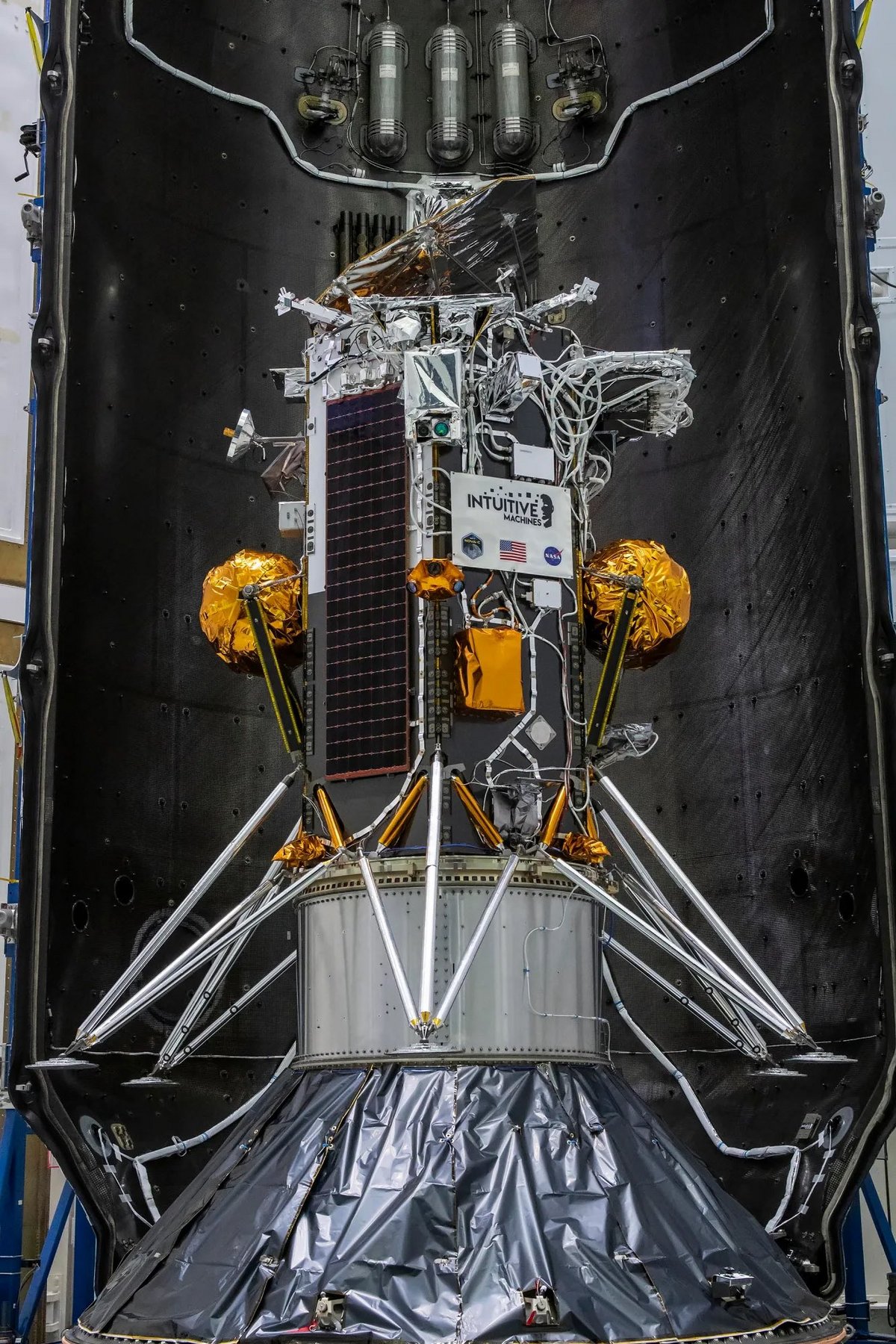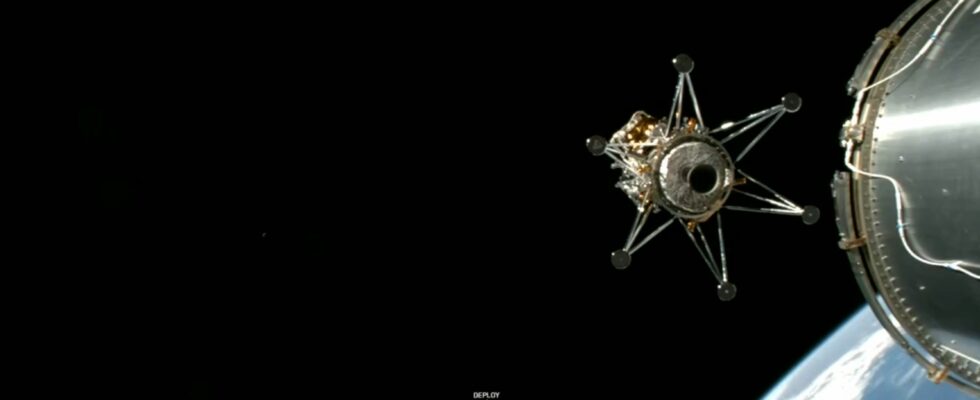- A lander the size of a Tardis
- A high-risk mission
- The descent, always a summary of danger
- A whole lot of NASA equipment
- More original projects
THE small Nova-C lander took off this morning from Florida, before being ejected towards the Moon. A new attempt to land there, already the third in 2024, and which will be just as risky. The private company, financed by NASA, will not prolong the suspense. Landing scheduled for February 22!
His little name is Odie, for Odysseus. A new lunar lander launched this morning from the Kennedy Space Center in California. At 7:05 a.m. (Paris), a SpaceX Falcon 9 rocket ignited its 9 engines before taking off and taking the Intuitive Machines vehicle on a trajectory that will take it directly to the Moon. The company, whose control center is located in Houston, Texas, immediately made contact, and so far the mission is going well. The pace of operations will be intense, since Odysseus is expected to land in the Malapert crater, approximately 300 km from the lunar South Pole, next Thursday, February 22.
A lander the size of a Tardis
Before talking about the lander itself, it should be noted that Intuitive Machines has not made it easy for the public, because the company uses a lot of different names. The vehicle is named Odysseus, the mission is called IM-1, and the vehicle model is Nova-C. That being said, it is very easy to recognize it, with its vertical design (4.3 m high), its six feet and its single motor dedicated to the main maneuvers.
Furthermore, there is nothing or almost nothing that involves mechanical deployment: the feet are already deployed, the solar panels cover its sides, the communication antenna is already out… Enough to minimize the risks, especially at the start of the mission.
Which does not mean that Nova-C is not innovative! With its 675 kg at takeoff, it is capable of theoretically carrying up to 130 kg of payloads to the lunar surface, thanks to an architecture designed and assembled around its two oxygen and liquid methane tanks, as well as than its 3D printed engine. An original propulsion for a lunar vehicle, which particularly attracted attention because SpaceX had to modify its launch facilities to be able to fill Odysseus’ tanks a few minutes before takeoff. The engine will be tested during a few maneuvers during the 6 days it will take to reach the Moon, then to brake and inject into lunar orbit, approximately 24 hours before attempting to land there.
A high-risk mission
Intuitive Machines believes that if Nova-C arrives exactly in position for its final minutes before descending to the lunar surface, then the criteria will be met for a successful mission. Because it’s no secret, landing on the Moon is a difficult exercise, especially for a private company and many others have struggled over the past 5 years, even while being operated on by states.
If only since the beginning of 2024, there has been the Japanese SLIM lander which landed headfirst, and Peregrine (Astrobotic), another American vehicle, which had a propulsion problem so serious that it disintegrated in the Earth’s atmosphere after a few days of travel. Odysseus is in a way a cousin of Peregrine, the two landers being partially financed by NASA within the CLPS project (pronounced “clips”, Commercial Lunar Payload Services) which consists of carrying payloads from the agency that the latter pays for at a high price as part of a public-private partnership.

The descent, always a summary of danger
Nova-C could therefore become the first American vehicle to land on the Moon since 1972, but for this it will still be necessary to successfully complete the important stage of descent. Like all other recent robotic vehicles, Odysseus will not be piloted remotely, the entire braking, guidance phase and the choice of the exact site to land will be autopiloted by the on-board computer. Intuitive Machines has spared no expense in trying to achieve this, with an adaptive algorithm based on the analysis of images from navigation cameras, merged with laser and radar altimeter readings. After an initial braking from the opposite side of the Moon, operations will remain paused for approximately an hour.
At an altitude of 10 km, Odysseus will once again ignite his engine, heading towards the Malapert crater. The engine will remain on throughout this phase, capable of varying its power according to navigation control data. The braking phase stops at approximately 2 km altitude, after which Nova-C switches to a vertical position for the end of its descent and attempts to calculate the exact location at which it will land, and if it does not detect no obstacle (he is in theory capable of avoiding them). At 30 meters altitude, it only goes 3m/s and at 10 m altitude, 1 meter per second. 15 seconds later, if it is still transmitting, then Intuitive Machines will have achieved a real technical feat.


A whole lot of NASA equipment
As this is a CLPS flight, NASA has several payloads on board. And for a good number of them, there is no question of waiting to be asked before starting the measurements. First, it is testing a new type of sensor installed on Nova-C tanks, which will study interior behavior using radio frequency emissions. Then there is the LN-1, for Node-1 Navigation Demonstrator. The latter is an autonomous device, which will attempt at any time to calculate the position of Odysseus during his mission. Upon arrival on the surface, NASA also wishes to study the cloud of lunar dust raised by the engine, with its stereoscopic SCALPSS sensor, and will also test during the descent a Doppler lidar sensor, capable in theory of calculating speed and distance by relation to the ground as precisely as conventional lasers and radars, but with a more compact device.
Finally, there are two experiments that will be useful during the 7 days that Intuitive Machines hopes to operate its vehicle on the surface, the ROLSES box which will study the electromagnetic environment, as well as a small omnidirectional optical reflector (passive). If the IM-1 mission works as planned, it will allow, like the reflectors deposited by Apollo or Lunokhod, to bounce laser signals onto the lunar surface from Earth.
More original projects
Being a private lander, there are also some special lunar payloads, including special thermal insulating fabrics, thanks to a unique partnership (or sponsorship) from Columbia, the clothing brand. He also has a very exciting (if it works) project from Embry-Riddle University: a small “selfie camera” that will be ejected when the lander is between 30 and 10 meters above the ground, and which should film the last part of the arrival of Odysseus. Obviously, this is a technological demonstration. There is also a sculpture by Jeff Koons, a prototype telescope operating from the lunar surface (first Hawaiian lunar instrument), an engraved Earth knowledge disk and a small active server which is also a prototype for future lunar data centers (when we want to store away from everything…).


So, after an impeccable takeoff and a successful arrival in space, will Intuitive Machines succeed in its first lunar bet? The small structure plays big…
Source : SPACE.com

0